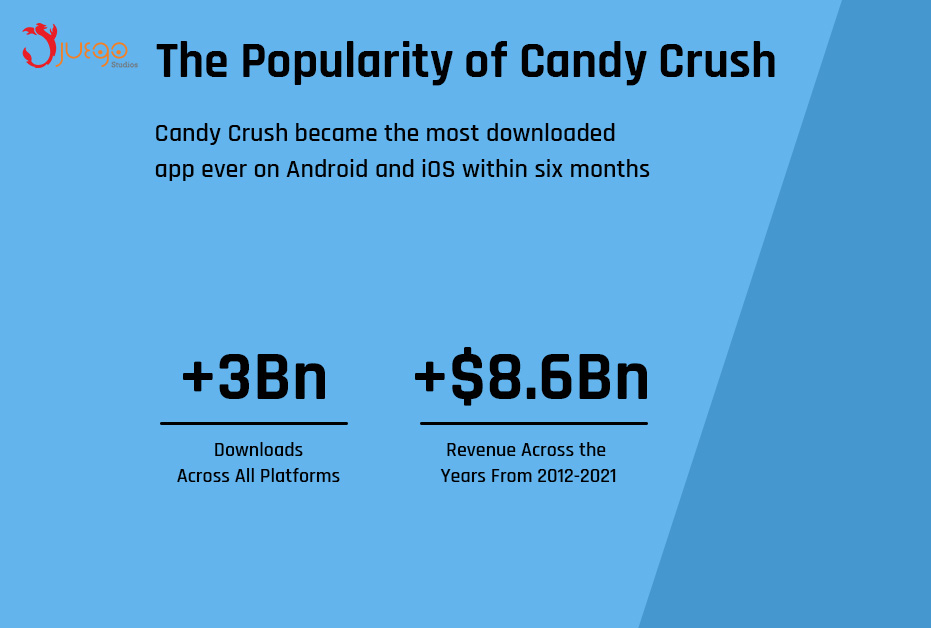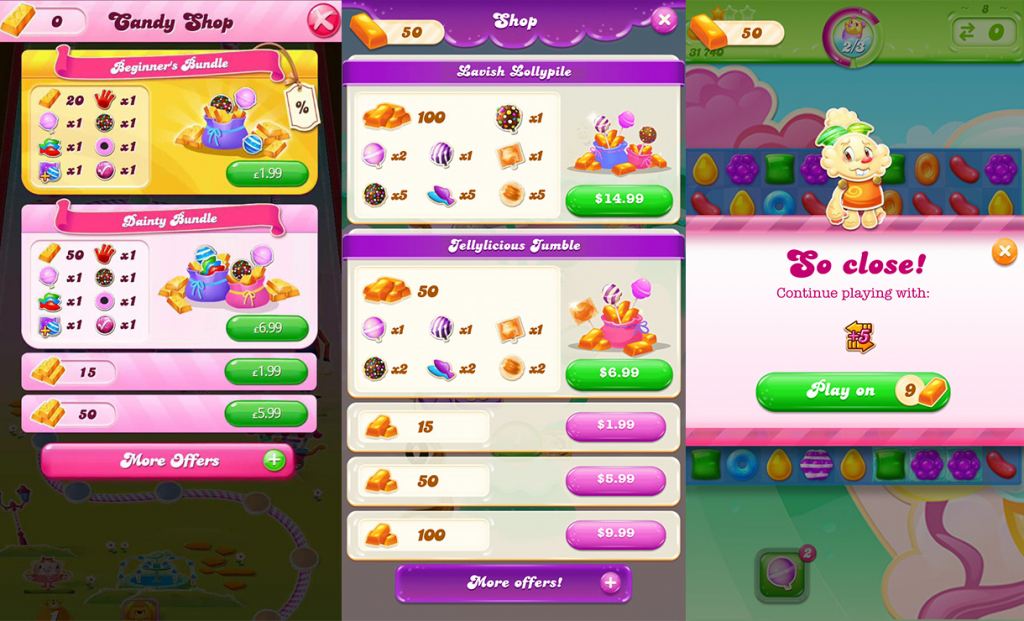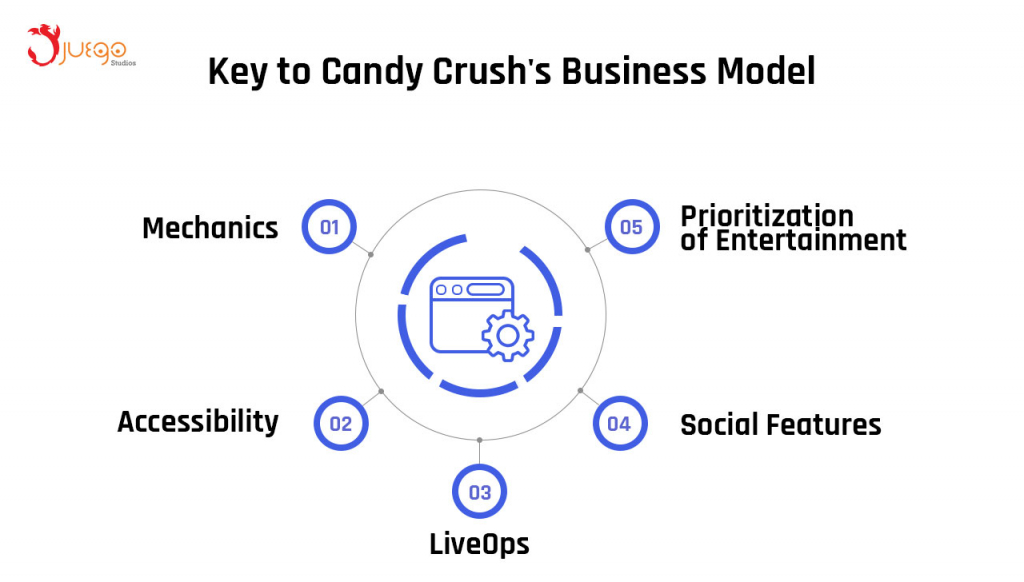Table of Contents
Candy Crush Saga is one of the highest-grossing games of all time.
This decade-old game, popular on mobile, earns millions each year. It is one of the most recognizable mobile games on the planet. In fact, it is one of the most recognizable video games ever.
Because Candy Crush is played by people from all demographics and walks of life.
It has also ushered in a plethora of copycat games that have been unable to hold a candle to Candy Crush in terms of quality, popularity, and influence.
But how has Candy Crush maintained its status at the top of the ladder for such a long time? How does Candy Crush make money?
Let’s have a closer look.
Candy Crush was created by King, a game development company from Sweden that has been creating games since 2003. The company gained fame in its initial years through its browser games which it released on its own website.
The idea for Candy Crush came to one of the co-founders in the unlikeliest of places: the bathtub. This initial idea was to create a match3 game that featured candies rather than other artifacts, such as gems and jewels, prevalent in games of the match3 genre at the time. Candies being a familiar and everyday item was also a reason behind this.
So, the team got to work. And on April 2012, King released the game on Facebook. Then, later in the same year, they released the game for mobile, on both iOS and Android.
All these versions became popular immediately.
Within the span of 8 months, Candy Crush overtook Farmville 2 as the most popular game on Facebook. Likewise, Candy Crush became the most downloaded app ever on Android and iOS within six months.

But the accolades didn’t stop there. It also became one of the first ever mobile games to reach a billion dollars in terms of revenue. More importantly, it started to occupy a place in the cultural zeitgeist, and at one point, it even seemed everyone in the world was playing it.
There are many reasons why the game enjoyed a surge in growth and popularity. One reason was the cross-platform support that lets players jump from one platform to another as per convenience. If a person is playing on their PC browser for a few hours, they could later hop onto their mobile and continue where they left off.
The immense success of Candy Crush Saga also led King to release multiple similar games, which, although they failed to become successes to the level of Candy Crush, nonetheless are successful games if considered in isolation. Among them are Candy Crush Soda Saga and Candy Crush Jelly Saga, two games that have been around for years and which have millions of downloads.
All this success attracted the notice of juggernauts in the industry. So, in 2015, Activision-Blizzard, the company behind classic video games such as World of Warcraft and Call of Duty, acquired King for $5.9 billion.
Years on, Candy Crush is still going strong.
More than ten years after its release, the game boasts 233 million active users per month. In terms of the number of downloads, the game has amassed 3 billion downloads across all the different platforms.
But if you want to know how much money Candy Crush has made over the years, you have to look at the year-by-year figures. In 2021, the game reported revenue of $1.21 billion, one of the highest in the industry. The revenues for 2020 and 2019, likewise, stood at $1.19 billion and $1.11 billion, respectively.

Furthermore, since 2017, the year-on-year growth of the game has been positive. If you are still eager to understand how much money does Candy Crush make at present, King has also reported that the game had a 20% YoY growth for every quarter in 2022.
For a game that is a decade older, these statistics are nothing short of impressive.
All of these figures might be making you wonder, how does this game make money?
The answer: The Freemium Model.
A freemium game is a game where the developers offer the complete game for free but with in-game purchases. The in-app purchases are usually minor gameplay enhancements like boosters or weapons or cosmetic enhancements like skins and costumes.
In the case of gameplay enhancements, these allow the players to advance within the game through additional assistance or the removal of certain barriers altogether. On the other hand, cosmetic enhancements offer no benefit in terms of in-game performance but are mere alterations in appearance.
The freemium model is the leading monetization model in the gaming industry. Games such as Honor of Kings, Fortnite, PUBG, and Clash of Clans also follow the same business model as Candy Crush.
There are several reasons why the strategy has overtaken other monetization strategies that have long been dominant in the gaming industry.
The main among them is that the payments are voluntary and not forced. It is not necessary for players to pay to enjoy the game. In fact, numerous people play to the end of these games without spending even a single penny.
The other reason is that most of the purchases are of relatively smaller amounts. Because of this, players might start out with smaller purchases and then later on branch onto the bigger ones once they see the benefits.
However, each game implements this model of monetization in its own way.
Candy Crush’s monetization model is closely related to its match3 core loop. At the beginning of the game, the player is given five lives. Every time the player fails to complete the level, one life from this gets exhausted. Then, once all five lives are exhausted, the game introduces a timer restricting further gameplay till the timer runs down.
Now, the player is faced with a choice: wait till the timer gets over or find a way to remove the timer.
Many opt to remove the timer.
And the best way to do this is by purchasing extra lives from the in-game store.

That requires players to purchase gold bars, the in-game currency, using real money. This gold bar that acts as an intermediate between real money and virtual money is a crucial factor in Candy Crush’s business model. Most purchases, including extra lives, are made using these gold bars.
There are other forms of IAPs as well, including boosters and power-ups, which can aid in gameplay during crucial times. These include Lollipop and Lucky Candy, each of which has its own use cases.
The first reason is the lower cost. King has priced the IAP bundles strategically to appeal to a wide range of audiences based on years of data. The bundles are also meaningful purchases to those hooked on the game.
Second, is the in-game currency. Most of the purchases in the game are with the in-game currency, but never directly with real money. The reason is that it lessens the hesitancy of players to make purchases. Players weigh the value of items in contrast with virtual currency rather than real money. Thus, the actual cost of each purchase is never obvious at first glance and thus prompts more purchases.
But despite all these tricks as part of Candy Crush’s business model, only a small percentage of the users make even a single purchase. Most users are free users.
But this is offset due to the sheer number of users Candy Crush has, that even the smallest percentage of purchasing leads to huge revenue. In addition, there are also players called ‘whales,’ an extremely small subset of users that spend a disproportionate amount of money inside the game. Whales account for a large percentage of revenue from freemium games, including Candy Crush.
Though freemium remains the main revenue model of Candy Crush, King has also explored other revenue generation strategies for the game.
The first is in-game advertisements. In fact, advertisements were the primary source of revenue during the initial years of Candy Crush. But in 2013, King decided to remove the advertisements altogether, citing that they had been receiving enough revenue from in-app purchases alone.
However, King decided to re-introduce ads to the game in 2018. Although it is far from being the main source of revenue, it is nonetheless a significant part of Candy Crush’s revenue model.
The format King uses for Candy Crush, however, differs a lot.
Because Candy Crush features a sub-set of in-game advertisements called Reward Ads. These are 30 to 60 second video ads that appear during transitions in the game, like, after the end of a level, and the players can decide whether to watch the ad or not to do so. If the player decides to watch the ad, they receive an in-game reward, such as a booster or a bundle of gold bars. If not, there are no negative repercussions.
Players warmly receive reward ads as these are not intrusive compared to other formats of ads. Also, they provide in-game benefits that actually enhance the players’ experience.
A third different revenue model that Candy Crush has are partnerships. In the past, King has partnered with franchises like Sonic and Space Jam to promote their movies. The game replaced in-game candies with franchise logos, characters, and mascots as part of the promotion.
All these were made part of the game’s design. And this brings us to the next topic.
Look, if not for the game’s great design, Candy Crush would not have monetized this well. The monetization model of the game is tied in closely with the game’s entire design, with both of them being intertwined with each other.

Now, let us have a look at how game design has played a key part in how candy crush makes money:
The match3 mechanics of swiping tiles up and down to match them is one of the simplest mechanics in gaming. It doesn’t take a genius with years of experience to understand the mechanics.
But at the same time, Candy Crush is also insanely hard to master. It often takes players several days to complete a single challenge. However, once completed, these provide users with a sense of accomplishment.
So, basically, the game lures players in with the ease of playing but retains them for the long term with its hard challenges. This perfect balance between simplicity and difficulty is among the reasons for Candy Crush’s popularity.
Candy Crush does not have a specific target audience. It is a game that is targeted toward practically everyone.
So how does one make money from a game that has its target users like everyone on earth?
The answer is accessibility.
Let’s start with the game’s mechanics itself. The match3 mechanics has the benefit of being adaptable to any platform. You can use it on mobile with touchscreen controls or on PC with click controls.
This adaptability has allowed King to release the game on multiple platforms. The ubiquity of smart devices has ensured practically anyone can play the game.
Since its first release in 2012, Candy Crush has seen numerous updates. Over the years, the game has amassed thousands of new levels.
Let us better illustrate this with a figure. On January 1st, 2020, the total number of levels available on Candy Crush was 6,000. As of writing this article, the game has 14,000 levels in total. This means more than double the number of levels created in the last three years than in the first eight years of the game’s lifespan.
All these levels engage the players for the long term. Because with each new significant update, they receive new levels to play, thus eliminating the need to opt for a newer game.
Candy Crush’s social features were one of its earlier pulls. It allowed us to turn a single-player gaming experience into a social and competitive one.
It helped players to outperform their friends, completing more levels than their friends had. It also prompted them to ask for help in the form of extra lives from their friends.
The developers of Candy Crush have been vocal about their prioritization of entertainment value over company revenue.
This underscores one of the most important aspects of game development: value to players.
Because for a game like Candy Crush to have survived for so long, it had to deliver immense value to its player base. This is especially vital in the current competitive atmosphere, where it seems as if there are more games than there are players.
Gamers deserve value for their time. If not, the next game is just a few clicks away. You have to make sure that yours is not the one they turn away from.
There are games that change the landscape of the industry forever.
These games revolutionize the industry, altering the course of games being developed at the present moment and chartering a path for games that are yet to be developed. These usher in a host of trends and practices that lay the groundwork for years to come.
The best of these leave such an important mark that those looking back will categorize history as being split between ‘before the game’ and after the game.
Candy Crush is one of these games.
Its legacy is not just limited to mobile games but spans the entire gaming industry. Numerous games have adopted the features it has. It also bought thousands of imitations, most of which cannot even hold a candle to King’s masterpiece.
How King monetizes Candy Crush is a lesson for game developers to follow. It is also a true testament to successful mobile game design.
It is, in fact, a king among games.
The best method to build a game like Candy Crush is by hiring a mobile game development company like Juego Studios. We are a team of 300+ that has created games of different genres for clients across the world, hailing from different industries.
Many who have read this blog would be wondering about the cost of developing their own game like Candy Crush.
A rough estimate we can provide for the development of a match3 game along the lines of Candy Crush would be between $50,000 to $150,000.
But the factors that determine the cost of the project would vary a lot based on the specifics of the project. The chief one is the complexity of the project, which includes the number of levels, the features, and the platforms to be released on, all of which would increase the cost. Other factors include the duration of the project, the art style of the project, and the experience of the team, with more experienced personnel being a factor in increased cost.
As per the data in 2021, Candy Crush’s revenue was $1.21 billion. The revenue figure changes from one year to the next.
Candy Crush generates revenue through a freemium model, offering the game for free while encouraging in-game purchases (IAPs) for gameplay enhancements or cosmetic items. Players can buy gold bars, the in-game currency, to purchase extra lives, boosters, and power-ups. Despite a small percentage of users making purchases, the vast user base ensures substantial revenue, further supplemented by in-game advertisements and partnerships.
As per the data in 2021, Candy Crush’s revenue was $1.21 billion. The revenue figure changes from one year to the next.
King uses the freemium model to monetize Candy Crush. It is the leading model in the gaming industry.
It is a well-designed game, that compared to all its competition, delivers a superior playing experience.